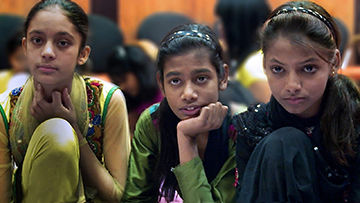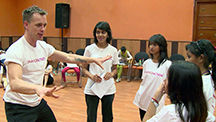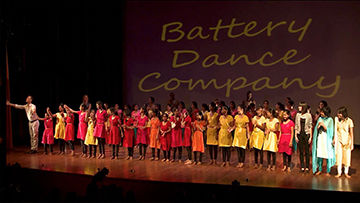Friends
Film Review: Moving Stories
Six itinerant dance teachers transform the lives of children around the world.
Posted March 9, 2018

It is not within the power of art to solve international humanitarian crises. But that’s not to say that “soft power”—persuading through cultural influence rather than by force—isn’t enormously forceful.
In this week’s news alone, amid growing tensions between France and Iran, The Louvre has opened an exhibit at Iran’s National Museum. Qatar and Turkey are boosting their strategic alliance by increasing their cultural exchange. Understanding that military power has its limits, India is engaging in Buddhist diplomacy.
Cultural diplomacy is typically employed country-to-country. But it can also work person-to-person. “Moving Stories” is a brilliant new documentary by Wilderness Films that shows dance as soft power supporting people that political and social failures have hurt.

The film profiles the Dancing to Connect program of New York City’s Battery Dance Company. In the season that “Moving Stories” portrays, six remarkably empathetic and inspirational teachers conduct one-week workshops with children in New Delhi, Bucharest, Busan, and Amman. In groups, the children improvise original dances that, by week’s end, they perform in large, traditional theaters—of the sort that many star-struck American children spend a lifetime fantasizing about stepping one foot on.
Initially, some of the New Delhi children in the program think they’ll be learning Bollywood dances rather than creating dances of self-expression. Their teachers are nurturing and careful with them, for these are slum children, some of whom have been rescued from sex trafficking and gender violence. The Bucharest children are Roma (gypsy); tough kids, or so they seem, they and their families live in one of Europe’s worst slums and are typically stigmatized as “criminals,” and “thieves.” In Busan, eleven traumatized North Korean teens who barely survived their escape to South Korea dance with seven Chinese defectors and nine South Korean teens. Also in Busan, a large group of orphaned teenage boys struggle against hormonal gloominess to create their own dance. In Amman, the “group” consists of only one dancer. He is a young hip-hop dancer who knows he would be killed were he to dance in public in his native Iraq. Having given him six months of steady Skype mentoring, Dancing to Connect puts him on stage. He dances gloriously, solo.
“The children come to this project not believing they can do what we are going to ask them to do. ‘Wait a second. We are going to create a dance piece, and it’s going to be performed by us in one week? No, No, No. Not possible.’ And then by one week they own something.” —Tadej Brdnik, teacher with Dancing to Connect
“My mother is no more. Now it’s just me and my little sister. I didn’t know I’d ever find such a beautiful thing in life as this. Our teacher here talks with love, like a father. He doesn’t scold or hit us or make mischief with us. I pray that everyone finds a teacher like him.”—A child from the slums of New Delhi
“Before I didn’t have friends. Dance helps me find friends.”—A Roma boy
“The fact that I’m dancing is a way of me showing my freedom. Now there is a good connection between me and the South Korean students, and I’m starting to open my heart to them."—A North Korean escapee
“Moving Stories” is about far more than how Dancing to Connect teaches stigmatized, abused, frightened children to dance. It is about how the children learn to unlock their hesitation and dance together. It is also about how they learn to create dances that express optimism alongside a full range of strong emotions. In each city, no matter how suspicious the children are at the outset of their week, by its end they allow themselves to be moved emotionally by dance and by each other. And they create polished performances that seem as spectacularly fun to dance as they are to witness.
To its vast credit, “Moving Stories” unfolds the children’s journeys without so much as a whisper of narration. Viewers are never told what to think or feel. They are instead invited to listen closely and to hear the emotion in the children’s voices and the warmth, tolerance, and fun in what the teachers have to say.
The movie opened to a sold-out audience at New York’s Museum of Modern Art on February 18. Its producers are pursuing theatrical and broadcast distribution as well as semi-theatrical opportunities like museums, community centers, church groups and universities.
With luck, “Moving Stories” and Dancing to Connect will inspire more adventures in creativity- and empathy-based cultural diplomacy. Art like this is not going to change the world as a whole. Evidently, though, it can make a royal difference for one scared soul at a time.
The trailer for “Moving Stories is here.



